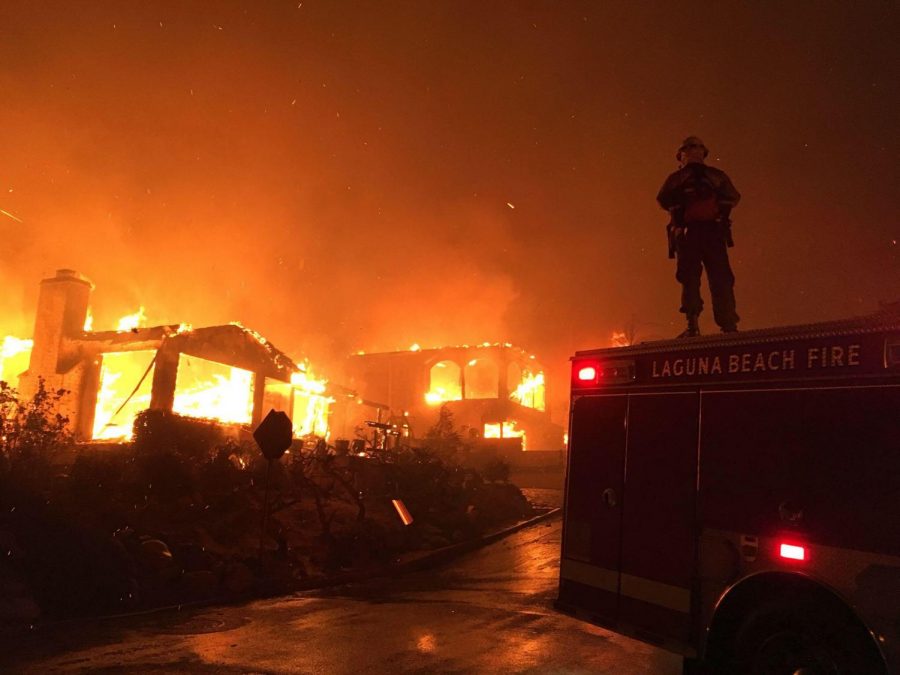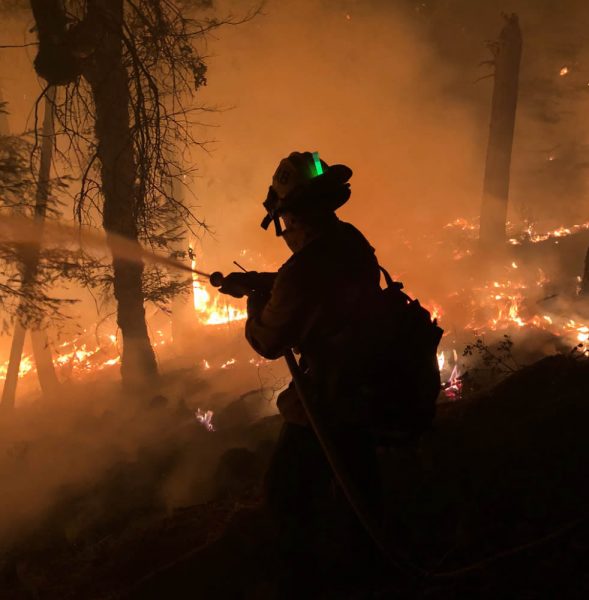Recent wildfires remind of Laguna’s vulnerability to disaster
Laguna Beach fire fighters helping to battle the recent Thomas Fire in Venutra California. LBFD members travel all over California to fight wildfires.
February 25, 2019
In the past year, California has experienced some of the largest and deadliest wildfires on record. Spanning from the Camp Fire in Butte County, Northern California to the Thomas Fire in Ventura and Santa Barbara Counties, California wildfires in 2018 alone have burned roughly 1,893,913 acres and claimed the lives of 98 civilians and 6 firefighters. The seemingly constant cycle of wildfires that ravaged California fuels memories of the Laguna Fire, beginning on Oct. 27, 1993, burning over 16,000 acres and destroying 400 homes.
“It was scary. You could feel the concussion of propane tanks exploding as the fire got closer. It was so smokey you couldn’t breathe for days,” said Laguna resident Ginger Virga, who experienced the fire firsthand.
In light of California’s and Laguna’s histories with rampant wildfires, it seems necessary to review Laguna’s susceptibility to fire.
“We live in a designated ‘very high fire severity’ zone. We have hills and topography. Our city comes right up against open space, making it vulnerable to wildfires,” said Laguna Beach Fire Department Division Chief Api Weinert regarding Laguna’s susceptibility to wildfires.
Given Laguna’s high risk of a severe wild fire, knowing where and when to go in the case of a fire can be the difference between life and death. Within Laguna itself, there are several evacuation sites where affected residents could go to seek shelter: These sites include Laguna Beach High School, El Morro Elementary School, Thurston Middle School and the Susi Q Senior Center. However, given that many of these locations could also be affected by a fire, it may be necessary to flee the city entirely during a fire.
“Be prepared and get out early. Don’t wait until the fire is at your door; the smoke will be so thick that it will cause your car not to run, you won’t be able to see, you’ll hit people and trees and go over the side of cliffs. A common mistake is that people wait too long to get out; and when they wait, it’s often too late,” said Weinert.
To get out of the city, residents should take either North Coast Highway or South Coast Highway and make their way to surrounding towns with designated evacuation sites, such as Capistrano Unified Schools, Salt Creek Park and Soka University. While trying to protect one’s home from a fire may seem like a good idea, evacuation is far safer and more practical.
“To think that you can stay behind and protect your house with a garden hose, will more often than not fail to work. Those garden hoses are a half inch in diameter; the hoses we use on the fire engine are an inch-and-a-half up to four inches. It takes a large volume of water to put out even a house fire,” said Weinert.
Rather than risking one’s life to protect a home, there are preventative measures that residents can take.
“How people build and maintain their property can help protect their homes from fire damage. Reducing the volume of vegetation surrounding a home by 25%-50% and clearing brush around a home can help give your house a better chance of surviving a fire. Also, being prepared and having a home emergency plan will definitely help in the case of a fire,” said Weinert.
In addition to these preventative strategies, residents can rest assured that the LBFD is exceptionally well prepared for a wildfire. Laguna Beach firefighters go across the state of California to fight fires, thus making them extremely qualified and capable of protecting Laguna from a burn.
As an added measure, the goat program massively reduces the risk of a wildfire in the vegetation that surrounds parts of the city. These goats chop, thin and cut the vegetation so that it will slow and reduce the fire’s intensity before it reaches homes.
“Knowing all of the measures taken by our fire department, I feel very confident that my family and I would be able to get out safe in the event of a wildfire,” said senior Rusty Hunter.








